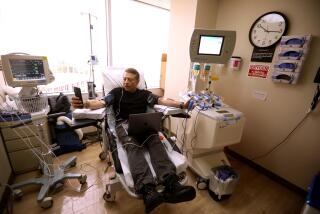An effective, but costly, cure
ASK RICHARD IDRO IF HE HAD MALARIA as a child, and you will begin to grasp the toll this disease takes on sub-Saharan Africa. Patiently, as though explaining breathing to a visiting Martian, he will answer, “Everybody got malaria.”Growing up in northwestern Uganda, Idro and his nine brothers and sisters had malaria “over and over,” especially after the war that toppled strongman Idi Amin destroyed their home and sent them to a crowded refugee camp. But Idro’s worst brush came when he was just a year old and lapsed into a coma from cerebral malaria, the most severe form. His mother prayed he would pull through.
The oft-told story of his survival inspired Idro to become a pediatrician when he grew up. Today, he is studying to add a doctorate to his medical degree, specializing in cerebral malaria at the Kenya Medical Research Institute.The story of malaria in the 30 years since Idro’s recovery isn’t nearly as uplifting. The mosquito-borne parasite has grown resistant to the drug that cured him. Malaria’s mortality rate is higher today than it has been in decades.
Yet it doesn’t have to be this way. Even in tropical Africa, where the Anopheles mosquitoes that transmit the parasites thrive, everybody doesn’t have to get malaria.Historically, vaccines have been responsible for reining in some of the world’s worst diseases. In an earlier editorial, we urged the United States and other wealthy nations to speed progress by committing in advance to a $4-billion purchasing fund, to be tapped only if an effective vaccine is developed. This innovative, market-based complement to the “push” of grants would “pull” more biotech firms and their armies of scientists into the search by guaranteeing a payoff for success.
But sub-Saharan Africa’s dying children can’t wait years for a vaccine. Here too the world’s wealthy nations can help, by creating a similar fund to pay for an exciting but expensive drug compound made from a Chinese herb.Good herb, bad name
The wormwood plant does not have good PR. When God wants to curse a people in the Old Testament, he threatens to feed them with wormwood and gall. The Book of Revelation says that a star called Wormwood will strike the Earth at Armageddon and poison the waters. So it’s a little surprising that a wormwood species, Artemisia annua, holds a key to curing the deadly, ancient plague of malaria.
Artemisia’s beneficial properties might never have been discovered were it not for Mao Tse-tung. During the Cultural Revolution, Mao ordered Chinese scientists to investigate ancient herbal remedies. In the 1970s, an archeological dig unearthed ancient texts, including recipes for herbal cures that may be as much as 2,000 years old. One of them identified artemisia as a cure for fevers; the scientists investigated and discovered that an agent extracted from the plant, artemisinin, was as effective at killing malaria parasites as existing drugs such as chloroquine. The discovery didn’t come a moment too soon, because the parasites were becoming resistant to chloroquine.
The newest malaria miracle cure is best used as a cocktail with other drugs, called artemisinin combination therapy. But ACT costs more than legions of Africa’s rural poor can afford. And without a market of consumers able to buy it, farmers outside China have little incentive to start growing the artemesia plant, while scientists aren’t encouraged to invest in finding a synthetic substitute and manufacturers have no motivation to increase production of the finished drug.What is needed is a global purchasing pool, separate from the one proposed to spur investment in vaccine research. Rather than guaranteeing a future market for a potential vaccine, the second fund would be tapped now to pay for an already existing cure.
The Washington-based Institute of Medicine, an independent organization that advises the U.S. government on health policy, last year proposed just such a plan. In a report written by a Nobel Prize-winning economist, it called on international organizations and world leaders to contribute $300 million to $500 million a year to a centralized procurement agency to buy ACTs at competitive prices, then resell them at lower prices to public and private distributors in countries battling malaria.
Instead of today’s market price of $2, ACT would cost consumers about 10 cents -- the same as the no-longer-effective but still ubiquitous chloroquine. We’d advocate doubling the pool to $1 billion to spur production and subsidize the price of insecticide-treated bed nets as well, delivering a one-two punch against the parasites and the mosquitoes that transmit them.
Existing aid programs such as the Global Fund to Fight AIDS, Tuberculosis and Malaria have built-in limits on long-range commitments and can’t provide the certainty required to boost drug or net production and get enough of these lifesaving tools into the hands of those who so desperately need them. A well-managed procurement agency could, while freeing other aid programs to fund the labor-intensive education drives that are key to making sure both drugs and nets are used properly. Yet the Institute of Medicine plan has attracted little notice from the world’s leaders, who don’t seem to understand the urgency: Even with new tools, the window for rolling back malaria’s mounting toll is alarmingly narrow.
The human cost
At the district hospital in Kilifi, the Kenya Medical Research Institute’s home on the coast, Idro makes the rounds of the intensive-care pediatric unit. The rains are late this year, and the unit is calm compared with the height of malaria season, when it admits 10 new cases a day while the regular ward admits three times that many. Still, infants and toddlers lie two to a cot, swaddled in the vivid cotton kangas that women along the coast use as skirts and to strap infants to their backs. Nurses are in such short supply that mothers stay to tend their children, sleeping on the floor by the bed at night. Malaria accounts for up to 40% of hospital admissions, taking its toll in lost days of school and work and lost chances to break poverty’s grip. With cerebral malaria, about one in 10 children who survive have paralysis, epilepsy, speech impairments, blindness or behavioral problems that range from inattention to aggression.
“When a child who was playing until yesterday, then got convulsions, and the next day is dead, it’s devastating,” Idro said. “And when a child has cerebral damage, sometimes we don’t know how to tell the mothers this child will not be the same.”
Even a new, effective drug won’t work miracles for those children, at least not instantly. Getting the right drugs at the right time and in the right dosage is hampered by poverty, isolation and a lack of understanding about what causes malaria.The best hope of staving off serious complications or death in children under 5, who have not yet developed any immunity to malaria, is to seek treatment within the first 24 hours of the onset of fever, chills or other symptoms.But parents who live on $1 or less a day and must mete out pennies often wait to see if a child’s fever is passing. Sometimes they will have only enough money to buy a single pill when multiple doses are needed, which hastens the parasite’s development of resistance by weakening but not killing it. The convulsions of cerebral malaria are still seen in some quarters as a sign the child has been bewitched, and parents will turn to a local healer.Village medicine
Local health ministries and international aid organizations are finding ways to overcome these barriers. Most Africans buy drugs without a prescription from a mud-hut shop rather than from a doctor or clinic. The Kenya Medical Research Institute runs a program that trains shopkeepers to dole out advice. The institute also works with herbal healers to refer ill children for treatment, a process made easier when a local witch doctor’s own child came down with convulsions and he turned to the district hospital for help.
In Uganda, the nonprofit African Medical and Research Foundation is recruiting volunteers in remote villages to dispense free drugs day or night and to monitor their use. But as in most of Africa, the drug they are dispensing, a combination of chloroquine and sulfadoxine-pyrimethamine, is losing its effectiveness.
The new therapy, ACT, is designed to stave off resistance. Artemisinin is combined with another anti-malarial drug, which doubles the chances of killing the parasites and lessens the likelihood that any would survive to develop resistance. The drug cocktail is packaged as a single pill to ensure that both are taken.
An international push and subsidy for the combination pill would both encourage its use and discourage the use of the herbal remedy alone. Parts of Asia now use just artemisinin to treat malaria. Should the parasites become resistant to it, which is inevitable if such use continues, that resistance will spread around the globe, just as resistance to chloroquine did. The miracle cocktail won’t work miracles any longer. And the best promise to halt and even reverse malaria will be gone until someone like Richard Idro, working long hours in his laboratory, develops a new miracle drug or a vaccine.
Tomorrow’s Richard Idro may not grow up to be that researcher. When he gets malaria, he may not survive.
More to Read
Sign up for Essential California
The most important California stories and recommendations in your inbox every morning.
You may occasionally receive promotional content from the Los Angeles Times.






